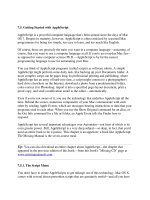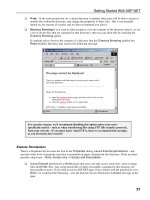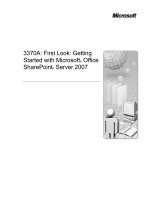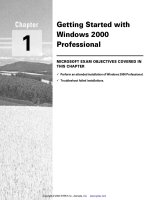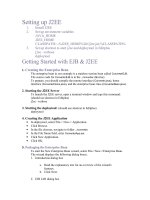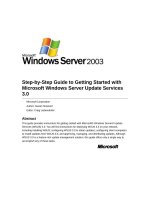Getting Started with RFID pdf
Bạn đang xem bản rút gọn của tài liệu. Xem và tải ngay bản đầy đủ của tài liệu tại đây (2.59 MB, 42 trang )
www.it-ebooks.info
www.it-ebooks.info
Getting
Started with
RFID
Tom Igoe
Beijing
•
Cambridge
•
Farnham
•
Köln
•
Sebastopol
•
Tokyo
www.it-ebooks.info
Getting Started with RFID
by Tom Igoe
Copyright © 2012 Tom Igoe. All rights reserved.
Printed in the United States of America.
Published by O’Reilly Media, Inc., 1005 Gravenstein Highway North, Sebastopol, CA 95472.
O’Reilly books may be purchased for educational, business, or sales promotional use. Online
editions are also available for most titles (). For more informa-
tion, contact our corporate/institutional sales department: (800) 998-9938 or
Editor: Brian Jepson
Production Editor: Teresa Elsey
Cover Designer: Mark Paglietti
Interior Designers: Ron Bilodeau and Edie Freedman
Illustrators: Robert Romano and Rebecca Demarest
March 2012:
First Edition.
Revision History for the First Edition:
March 09, 2012 First release
See for release details.
Nutshell Handbook, the Nutshell Handbook logo, and the O’Reilly logo are registered trademarks
of O’Reilly Media, Inc. Getting Started with RFID and related trade dress are trademarks of O’Reilly
Media, Inc.
Many of the designations used by manufacturers and sellers to distinguish their products are
claimed as trademarks. Where those designations appear in this book, and O’Reilly Media, Inc.,
was aware of a trademark claim, the designations have been printed in caps or initial caps.
While every precaution has been taken in the preparation of this book, the publisher and author
assume no responsibility for errors or omissions, or for damages resulting from the use of the
information contained herein.
The font used in the figures is Architects Daughter, provided by Google Web Fonts under SIL
Open Font License 1.1.
ISBN: 978-1-449-32418-6
[LSI]
1331238382
www.it-ebooks.info
Contents
Preface
. . . . . . . . . . . . . . . . . . . . . . . . . . . . . . . . . . . . . . . . . . . . . . . . . . . . . . . . . . . . . . . v
1/Radio Frequency Identification . . . . . . . . . . . . . . . . . . . . . . . . . . . . . . . . . . . . . . . 1
2/Reading RFID Tags in Processing . . . . . . . . . . . . . . . . . . . . . . . . . . . . . . . . . . . . . 5
Materials . . . . . . . . . . . . . . . . . . . . . . . . . . . . . . . . . . . . . . . . . . . . . . . . . . . . . . . . . . . .5
Parallax RFID Reader . . . . . . . . . . . . . . . . . . . . . . . . . . . . . . . . . . . . . . . . . . . . . . . . . 5
The Circuit . . . . . . . . . . . . . . . . . . . . . . . . . . . . . . . . . . . . . . . . . . . . . . . . . . . . . . . . . . 6
Try It . . . . . . . . . . . . . . . . . . . . . . . . . . . . . . . . . . . . . . . . . . . . . . . . . . . . . . . . . . . . . . . 7
3/Reading RFID Tags in Arduino . . . . . . . . . . . . . . . . . . . . . . . . . . . . . . . . . . . . . . . 11
Materials . . . . . . . . . . . . . . . . . . . . . . . . . . . . . . . . . . . . . . . . . . . . . . . . . . . . . . . . . . . 11
The Circuit . . . . . . . . . . . . . . . . . . . . . . . . . . . . . . . . . . . . . . . . . . . . . . . . . . . . . . . . . 12
Try It . . . . . . . . . . . . . . . . . . . . . . . . . . . . . . . . . . . . . . . . . . . . . . . . . . . . . . . . . . . . . . 12
Searching for a Specific Tag . . . . . . . . . . . . . . . . . . . . . . . . . . . . . . . . . . . . . . . . . . 14
4/RFID Meets Home Automation . . . . . . . . . . . . . . . . . . . . . . . . . . . . . . . . . . . . . . . 19
Materials . . . . . . . . . . . . . . . . . . . . . . . . . . . . . . . . . . . . . . . . . . . . . . . . . . . . . . . . . . 20
The Circuit . . . . . . . . . . . . . . . . . . . . . . . . . . . . . . . . . . . . . . . . . . . . . . . . . . . . . . . . . 20
Try It . . . . . . . . . . . . . . . . . . . . . . . . . . . . . . . . . . . . . . . . . . . . . . . . . . . . . . . . . . . . . . 21
Switching Power with RFID . . . . . . . . . . . . . . . . . . . . . . . . . . . . . . . . . . . . . . . . . . . 22
5/Conclusion . . . . . . . . . . . . . . . . . . . . . . . . . . . . . . . . . . . . . . . . . . . . . . . . . . . . . . . . . 27
Contents iii
www.it-ebooks.info
www.it-ebooks.info
Preface
The process of identifying physical objects is such a fundamental part of our
experience that we seldom think about how we do it. We use our senses, of
course: we look at, feel, pick up, shake and listen to, smell, and taste objects
until we have a reference for them—then we give them a label. The whole
process relies on some pretty sophisticated work by our brains and bodies,
and anyone who’s ever dabbled in computer vision or artificial intelligence
in general can tell you that teaching a computer to recognize physical objects
is no small feat. Just as it’s easier to determine location by having a human
being narrow it down for you, it’s easier to distinguish objects computation-
ally if you can limit the field, and if you can label the important objects.
Just as we identify things using information from our senses, so do com-
puters. They can identify physical objects only by using information from
their sensors. One of the best-known digital identification techniques is radio
frequency identification, or RFID. The network identity of a physical object
can be centrally assigned and universally available, or it can be provisional.
It can be used only by a small subset of devices on a larger network or used
only for a short time. RFID is an interesting case in point. The RFID tag pasted
on the side of a book may seem like a universal marker, but what it means
depends on who reads it. The owner of a store may assign that tag’s number
a place in his inventory, but to the consumer who buys it, it means nothing
unless she has a tool to read it and a database in which to categorize it. She
has no way of knowing what the number meant to the store owner unless
she has access to his database. Perhaps he linked that ID tag number to the
book’s title or to the date on which it arrived in the store. Once it leaves the
store, he may delete it from his database, so it loses all meaning to him. The
consumer, on the other hand, may link it to entirely different data in her own
database, or she may choose to ignore it entirely, relying on other means to
identify it. In other words, there is no central database linking RFID tags and
the things they’re attached to, or who’s possessed them.
Like locations, identities become more uniquely descriptive as the context
they describe becomes larger. For example, knowing that my name is Tom
doesn’t give you much to go on. Knowing my last name narrows it down some
more, but how effective that is depends on where you’re looking. In the Uni-
ted States, there are dozens of Tom Igoes. In New York, there are at least
three. When you need a unique identifier, you might choose a universal label,
www.it-ebooks.info
like using my Social Security number, or you might choose a provisional
label, like calling me “Frank’s son Tom.” Which you choose depends on your
needs in a given situation. Likewise, you may choose to identify physical
objects on a network using universal identifiers, or you might choose to use
provisional labels in a given temporary situation.
The capabilities assigned to an identifier can be fluid as well. Taking the RFID
example again: in the store, a given tag’s number might be enough to set off
alarms at the entrance gates or to cause a cash register to add a price to
your total purchase. In another store, that same tag might be assigned no
capabilities at all, even if it’s using the same protocol as other tags in the
store. Confusion can set in when different contexts use similar identifiers.
Have you ever left a store with a purchase and tripped the alarm, only to be
waved on by the clerk who forgot to deactivate the tag on your purchase?
Try walking into a Barnes & Noble bookstore with jeans you just bought at a
Gap store, and you might trip the alarms if the two companies use the same
RFID tags but don’t set their security systems to filter out tags that are not
in their inventory.
NOTE: This short book presents a couple of RFID
projects for Processing and Arduino from the first
edition of Making Things Talk (O’Reilly 2007). When
this book was updated to a second edition in 2011,
the RFID examples were updated to work with
newer RFID readers, specifically those that intero-
perate with the Near-Field Communications (NFC)
readers found in mobile phones such as the Nexus
S. Because there is still interest in the Parallax RFID
reader used in the first edition, this book is here to
preserve those projects for anyone who’s interes-
ted in building them.
Who This Book Is For
If you’ve got some experience with Arduino and Processing, and are curious
to experiment with radio frequency identification, this book is for you. You
won’t need any advanced skills: as long as you know enough about Arduino
and Processing to run simple sketches, and are able to connect basic circuits
on a breadboard with jumper wire, you’ll be able to use this book. If you don’t
have any experience with Arduino or Processing, the book Getting Started
with Arduino, second edition, by Massimo Banzi (O’Reilly) and Getting
vi Preface
www.it-ebooks.info
Started with Processing by Casey Reas and Ben Fry (O’Reilly) will get you
started.
Companion Kit
A kit is coming soon from Maker Shed to go along with this book. It will include
all the components you’ll need, from the Arduino to the RFID reader. For
more information, see />Conventions Used in This Book
The following typographical conventions are used in this book:
Italic
Indicates new terms, URLs, email addresses, filenames, and file exten-
sions.
Constant width
Used for program listings, as well as within paragraphs to refer to pro-
gram elements such as variable or function names, databases, data
types, environment variables, statements, and keywords.
Constant width bold
Shows commands or other text that should be typed literally by the user.
Constant width italic
Shows text that should be replaced with user-supplied values or by val-
ues determined by context.
TIP: This icon signifies a tip, suggestion, or general
note.
CAUTION: This icon indicates a warning or caution.
Using Code Examples
This book is here to help you get your job done. In general, you may use the
code in this book in your programs and documentation. You do not need to
contact us for permission unless you’re reproducing a significant portion of
the code. For example, writing a program that uses several chunks of code
Preface vii
www.it-ebooks.info
from this book does not require permission. Selling or distributing a CD-ROM
of examples from O’Reilly books does require permission. Answering a
question by citing this book and quoting example code does not require per-
mission. Incorporating a significant amount of example code from this book
into your product’s documentation does require permission.
We appreciate, but do not require, attribution. An attribution usually includes
the title, author, publisher, and ISBN. For example: “Getting Started with
RFID by Tom Igoe (O’Reilly). Copyright 2012 Tom Igoe, 978-1-449-32418-6.”
If you feel your use of code examples falls outside fair use or the permission
given above, feel free to contact us at
Safari® Books Online
Safari Books Online (www.safaribooksonline.com) is an on-
demand digital library that delivers expert content in both book
and video form from the world’s leading authors in technology
and business. Technology professionals, software developers,
web designers, and business and creative professionals use
Safari Books Online as their primary resource for research,
problem solving, learning, and certification training.
Safari Books Online offers a range of product mixes and pricing programs
for organizations, government agencies, and individuals. Subscribers have
access to thousands of books, training videos, and prepublication manu-
scripts in one fully searchable database from publishers like O’Reilly Media,
Prentice Hall Professional, Addison-Wesley Professional, Microsoft Press,
Sams, Que, Peachpit Press, Focal Press, Cisco Press, John Wiley & Sons,
Syngress, Morgan Kaufmann, IBM Redbooks, Packt, Adobe Press, FT Press,
Apress, Manning, New Riders, McGraw-Hill, Jones & Bartlett, Course Tech-
nology, and dozens more. For more information about Safari Books Online,
please visit us online.
How to Contact Us
Please address comments and questions concerning this book to the
publisher:
O’Reilly Media, Inc.
1005 Gravenstein Highway North
Sebastopol, CA 95472
800-998-9938 (in the United States or Canada)
707-829-0515 (international or local)
viii Preface
www.it-ebooks.info
707-829-0104 (fax)
We have a web page for this book, where we list errata, examples, and any
additional information. You can access this page at:
/>To comment or ask technical questions about this book, send email to:
For more information about our books, courses, conferences, and news, see
our website at .
Find us on Facebook: />Follow us on Twitter: />Watch us on YouTube: />Preface ix
www.it-ebooks.info
www.it-ebooks.info
1/Radio Frequency
Identification
Like bar code recognition, RFID relies on tagging objects in order to identify
them. Unlike bar codes, however, RFID tags don’t need to be visible to be
read. An RFID reader sends out a short-range radio signal, which is picked
up by an RFID tag. The tag then transmits back a short string of data. De-
pending on the size and sensitivity of the reader’s antenna and the strength
of the transmission, the tag can be several feet away from the reader, en-
closed in a book, box, or item of clothing. In fact, some large clothing man-
ufacturers are now sewing RFID tags into their merchandise, to be removed
by the customer.
There are two types of RFID system: passive and active. Passive RFID tags
contain an integrated circuit that has a basic radio transceiver and a small
amount of nonvolatile memory. They are powered by the current that the
reader’s signal induces in their antennas. The received energy is just enough
to power the tag to transmit its data once, and the signal is relatively weak.
Most passive readers can only read tags a few inches to a few feet away.
In an active RFID system, the tag has its own power supply and radio trans-
ceiver, and transmits a signal in response to a received message from a
reader. Active systems can transmit for a much longer range than passive
systems, and are less error-prone. They are also much more expensive. If
you’re a regular automobile commuter and you have to pass through a toll
gate in your commute, you’re probably an active RFID user. Systems like
E-ZPass, shown in Figure 1-1, use active RFID tags so that the reader can be
placed several meters away from the tag.
1
www.it-ebooks.info
Figure 1-1. An E-ZPass active RFID tag mounted on a car’s windshield
You might think that because RFID is radio-based, you could use it to do radio
distance ranging as well, but that’s not the case. Neither passive nor active
RFID systems are typically designed to report the signal strength received
from the tag. Without this information, it’s impossible to use RFID systems
to determine the actual location of a tag. All the reader can tell you is that
the tag is within reading range. Although some high-end systems can report
the tag signal strength, the vast majority of readers are not made for location
as well as identification. You can do some limited location detection using
multiple readers, however. Because most passive RFID readers (like the one
used in this book) have a short range, you can be assured that if you get a
signal from a tag on a particular reader, the tag is within a few centimeters
of the reader. By using an array of readers spaced half a meter or so apart,
you could determine the rough location of a tag by knowing that it’s in a given
reader’s range.
RFID systems vary widely in cost. Active systems can cost tens of thousands
of dollars to purchase and install. Commercial passive systems can also be
expensive. A typical passive reader that can read a tag a meter away from
the antenna typically costs a few thousand dollars. At the low end, short-
range passive readers can come as cheap as $30 or less. As of this writing,
$30 to $100 gets you a reader that can read a few centimeters. Anything
that can read a longer distance will be more expensive.
There are many different RFID protocols, just as with bar codes. Short-range
passive readers come in at least three common frequencies: two low-fre-
quency bands at 125 and 134.2 Khz, and high-frequency readers at
2 Getting Started with RFID
www.it-ebooks.info
13.56MHz. The higher-frequency readers allow for faster read rates and
longer-range reading distances. In addition to different frequencies, there
are also different protocols. For example, in the 13.56 band alone, there are
the ISO 15693 and ISO 14443 and 14443-A standards; within the ISO 15693
standard, there are different implementations by different manufacturers:
Philips’ I-Code, Texas Instruments’ Tag-IT HF, Picotag, and implementa-
tions by Infineon, STMicroelectronics, and others. Within the ISO 14443
standard, there’s Philips’ Mifare, Mifare UL, ST’s SR176, and others. So you
can’t count on one reader to read every tag. You can’t even count on one
reader to read all the tags in a given frequency range. You have to match the
tag to the reader.
There are a number of inexpensive and easy-to-use readers on the market
now, covering the range of passive RFID frequencies and protocols. Maker
Shed sells a 125KHz reader from Parallax that can read EM Microelectronic
tags, such as EM4001 tags. It has a built-in antenna, and the whole module
is about 2.5″ × 3.5″, on a flat circuit board. The EM4001 protocol isn’t as
common in everyday applications as the Mifare protocol, a variation on the
ISO 14443 standard in the 13.56 MHz range. This book doesn’t cover the
Mifare tags, but Making Things Talk, second edition (O’Reilly, 2011) does.
RFID tags come in a number of different forms, as shown in Figure 1-2: sticker
tags, coin discs, key fobs, credit cards, playing cards, even capsules de-
signed for injection under the skin. The last are used for pet tracking and are
not designed for human use, though there are some adventurous hackers
who have had these tags inserted under their own skin. Like any radio signal,
RFID can be read through a number of materials, but it is blocked by any kind
of RF shielding, like wire mesh, conductive fabric lamé, metal foil, or ada-
mantium skeletons. This feature means that you can embed it in all kinds of
projects, as long as your reader has the signal strength to penetrate.
Before picking a reader, think about the environment in which you plan to
deploy it, and how that affects both the tags and the reading. Will the envi-
ronment have a lot of RF noise? In what range? Consider a reader outside
that range. Will you need a relatively long-range read? If so, look at the active
readers, if possible. If you’re planning to read existing tags rather than tags
you purchase yourself, research carefully in advance, because not all read-
ers will read all tags. Pet tags can be some of the trickiest, as many of them
operate in the 134.2 KHz range, where there are fewer readers to choose
from.
In picking a reader, you also have to consider how it behaves when tags are
in range. For example, even though the Parallax reader used in this book and
a compatible reader from ID Innovations can read the same tags, they be-
have very differently when a tag is in range. The ID Innovations reader reports
Radio Frequency Identification 3
www.it-ebooks.info
the tag ID only once. The Parallax reader reports it continually until the tag
is out of range. The behavior of the reader can affect your project design, as
you’ll see later on.
The Parallax reader has a TTL serial interface, so it can be connected to a
microcontroller or a USB-to-serial module very easily. You’ll see sketches in
Processing (which run on a computer and connect to the reader over USB-
to-serial) for the Parallax reader in this book, in fact.
Figure 1-2. Various RFID tags
4 Getting Started with RFID
www.it-ebooks.info
2/Reading RFID Tags
in Processing
In this project, you’ll read some RFID tags and get a sense of how the readers
behave. You’ll see how far away from your reader a tag can be read. This is
a handy test program for use any time you’re adding RFID to a project.
Materials
RFID reader
Parallax’s RFID Reader Module, available from Maker Shed as part of a
starter pack or by itself.
RFID tags
The starter pack includes several tags, and you can buy them
separately.
USB-to-TTL serial adaptor
The FTDI Friend can do the job.
Breadboard
You can use a half-size or mini breadboard to make connections be-
tween the reader and the USB-to-TTL serial adaptor.
Jumper wire
You’ll need a set of jumper wire to make your connections.
Parallax RFID Reader
The Parallax reader is one the simplest readers available. It communicates
serially at 2400 bps. When the Enable pin is held low (connected to ground),
it sends a reading whenever a tag is in range. The tag ID is a 12-byte string
starting with a carriage return (ASCII 13) and finishing with a newline (ASCII
10). The ten digits in the middle are the unique tag ID. The EM4001 tags
format their tag IDs as ASCII-encoded hexadecimal values, so the string will
never contain anything but the ASCII digits 0 through 9 and the letters A
through F.
5
www.it-ebooks.info
The Circuit
The circuit for this reader is very simple. Connect the module to 5V and
ground, and connect the reader’s serial transmit line (labeled SOUT) to the
serial adaptor’s serial receive line (labeled RX). You’ll also need to attach the
enable pin to ground. Figure 2-1 shows these connections.
Figure 2-1. Wiring the RFID reader to the FTDI Friend
6 Getting Started with RFID
www.it-ebooks.info
Try It
The following Processing sketch waits for twelve serial bytes, strips out the
carriage return and the newline, and prints the rest to the screen. Before you
run this sketch, plug the FTDI Friend into your computer with a USB Mini
cable.
NOTE: You will probably need to look at the output
of Serial.list() and change the number on the
next line of code match the serial port that corre-
sponds to your microcontroller.
/*
Parallax RFID Reader
language: Processing
*/
// import the serial library
import processing.serial.*;
Serial rfidPort; // the serial port you're using
String tagID = ""; // the string for the tag ID
void setup() {
size(600, 200);
// list all the serial ports
println(Serial.list());
// based on the list of serial ports printed from the
// previous command, change the 0 to your port's number
String portnum = Serial.list()[0];
// initialize the serial port
rfidPort = new Serial(this, portnum, 2400);
// incoming string from reader will have 12 bytes:
rfidPort.buffer(12);
// create a font with the third font available to the system:
PFont myFont = createFont(PFont.list()[2], 24);
textFont(myFont);
}
Reading RFID Tags in Processing 7
www.it-ebooks.info
void draw() {
// clear the screen:
background(0);
// print the string to the screen
text(tagID, width/4, height/2 - 24);
}
/*
this method reads bytes from the serial port
and puts them into the tag string.
It trims off the \r and \n
*/
void serialEvent(Serial rfidPort) { //
tagID = trim(rfidPort.readString());
}
Here’s an explanation of the key parts of the code:
This line imports the serial library that comes with Processing. With it,
you’ll be able to use serial functions later in this sketch.
This line will print all the available serial ports to the Processing console.
You should examine the output of this command and identify which of
your serial ports corresponds to the FTDI Friend that’s plugged into your
computer.
If the output of the previous line of code was anything other than the first
serial port (index 0), change the 0 in this line to the index of the correct
serial port.
This line begins serial communications at 2400 bits per second.
Processing’s draw() function runs continuously as long as the sketch is
running. This line will display whatever’s in the tagID variable to the
screen, even if it’s still blank.
This function is invoked any time there’s some incoming activity on the
serial port. When the Parallax reader sends something to the Processing
sketch, it will be a tag id. This line puts that tag’s ID into the tagID variable.
Figure 2-2 shows the results of holding a tag up to the reader while this Pro-
cessing sketch is running.
8 Getting Started with RFID
www.it-ebooks.info
Figure 2-2. The Processing sketch reading a tag
Reading RFID Tags in Processing 9
www.it-ebooks.info
www.it-ebooks.info
3/Reading RFID Tags
in Arduino
In this project, you’ll connect Arduino directly to the RFID reader. This project
accomplishes the same thing as the project in Chapter 2, but the reader is
connected to an Arduino, not to your computer. As a starter step, you’ll see
how to read in an RFID tag’s ID and send its value to a computer over the
serial port. After you’ve done that, you’ll see how to read in an RFID tag’s ID
and compare it to a stored tag ID: if you wave the right tag at the RFID reader,
it will light an LED. In this way, the RFID tag will behave as a key.
WARNING: Some RFID tags have many well-
documented vulnerabilities. Certain types of RFID
tags can be cloned easily, for example. So in theory,
if an attacker gets close enough to your RFID tag
(or you code) to determine the ID of the tag, they
may be able to create a copy of it.
Materials
Arduino
The Arduino Uno is a good model of Arduino to get started with for all
the microcontroller-based projects in this book.
RFID reader
Parallax’s RFID Reader Module, available from Maker Shed as part of a
starter pack or by itself.
RFID tags
The starter pack includes several tags, and you can buy them sepa-
rately.
Breadboard
You can use a half-size or mini breadboard to make connections be-
tween the reader and the USB-to-TTL serial adaptor.
Jumper wire
You’ll need a set of jumper wire to make your connections.
11
www.it-ebooks.info
The Circuit
The circuit for this reader is similar to the one from Chapter 2. Connect the
module to the Arduino’s 5V and ground connections, and connect the
reader’s serial transmit line (labeled SOUT) to digital pin 6 on the Arduino,
which we’ll enable as a secondary serial port by using Arduino’s Software-
Serial library (the Arduino Uno has a primary serial port that we’ll use to send
messages to the computer). You’ll also need to attach the enable pin to
ground. Figure 3-1 shows these connections.
Try It
This sketch reads in bytes similar to the Processing sketches shown in
Chapter 2. Upload it to your Arduino, launch the Arduino Serial Monitor
(Tools→Serial Monitor), and make sure the Serial Monitor is configured for
9600 bps. Next, bring an RFID tag within range of the reader, and you should
see the tag ID appear in the Serial Monitor window.
/*
RFID Reader
*/
#include <SoftwareSerial.h> // Bring in the software serial library
const int tagLength = 10; // each tag ID contains 10 bytes
const int startByte = 0x0A; // Indicates start of a tag
const int endByte = 0x0D; // Indicates end of a tag
char tagID[tagLength + 1]; // array to hold the tag you read
const int rxpin = 6; // Pin for receiving data from the RFID reader
const int txpin = 7; // Transmit pin; not used
SoftwareSerial rfidPort(rxpin, txpin); // create a Software Serial port
void setup() {
// begin serial communication with the computer
Serial.begin(9600);
// begin serial communication with the RFID module
rfidPort.begin(2400);
}
void loop() {
// read in and parse serial data:
if (rfidPort.available() > 0) { //
if (readTag()) { //
12 Getting Started with RFID
www.it-ebooks.info
Serial.println(tagID);
}
}
}
/*
This method reads the tag, and puts its
ID in the tagID
*/
boolean readTag() {
char thisChar = rfidPort.read(); //
if (thisChar == startByte) { //
if (rfidPort.readBytesUntil(endByte, tagID, tagLength)) { //
return true;
}
}
return false;
}
Here’s how the code works:
This line imports a library called SoftwareSerial, which allows you to use
any pair of digital pins as a serial port. It’s not as robust as the built-in
hardware serial port (pins 0 and 1), but it is well-behaved at low trans-
mission rates, which is perfect here, since we’re communicating with the
RFID reader at 2400 bits per second.
These lines of code declare several constants used throughout the
sketch. The first, tagLength, is the number of characters in the RFID tags
that the Parallax reader can process. The second, startByte, is the value
of the character that the RFID reader sends when it’s beginning to trans-
mit a tag ID. And the last, endByte, is what the RFID reader uses to signal
that it’s done transmitting a tag ID.
This line declares a buffer (tagID) that’s big enough to hold the tag ID,
along with an extra byte at the end to hold the character (zero) that ter-
minates a character array. This way, when you use the println command
to display the tagID later, the zero will signify to Arduino that it’s reached
the end of the string.
This initializes the Software Serial session with pin 6 as the receiving pin,
and 7 as the transmitting pin. Since you don’t transmit anything to the
RFID reader, you don’t need to hook pin 7 up. In the setup() module, you’ll
Reading RFID Tags in Arduino 13
www.it-ebooks.info


